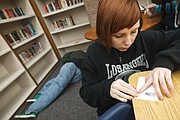Dramatic learning: CSI at Project CDA
COEUR d'ALENE - A motionless form clothed in sneakers, jeans and a hooded sweatshirt lay on the floor Tuesday at Project CDA.
Yellow crime tape cordoned off the area of the high school library.
Between some books, on a shelf above the head of the crime victim - a dummy named "Noah Body" - was a pool of red.
"In the blood we have the confirmed presence of barbiturates, LSD, and possibly lead," said Jeff Nordin, an 18-year-old student at Project.
Nordin sat with several classmates in the library. Bottles of red and yellow liquids, and a tray with several brightly colored test samples, rested on the table in front of them.
Welcome to "CSI 271" - a new forensics class offered as a third-year science course this year at Project CDA, an alternative high school in the Coeur d'Alene School District.
The toxicology screening was completed by Nordin and other students using simulated body fluids.
At another table, pupils were performing a chemical analysis of soil found near the crime victim.
"We're checking reactivity to metals," explained Buddy Kaylor, 18.
Other pupils had lifted fingerprints from the area near the fake body.
"That's obviously from the right hand. Look at the pinky," said teacher Phyllis Tuttle as she reviewed sheets of oval swirl- and- whirl-marks.
Science teachers are always looking for ways to take their lessons out of the books and make them real for students, Tuttle said.
Tuttle, whose father worked in law enforcement, earned an EXCEL Foundation grant that paid for the student crime lab resources.
The supplies are authentic, right down to a box of simulated blood that reacts to luminol.
"Everything about this is hands-on and that's fabulous. Figuring out the basics is just an amazing process," Tuttle said. "You have kids thinking on a very high level and doing the science."
Some students were analyzing the ink on a note found near the body. The words penned by the writer: "I will get even Noah. You'd better watch your back."
Nathan Drapeau, 16, held up the note which was dotted with small holes, showing the spots where students had scraped ink from the paper to compare it to ink from a pen found on a suspect. They treated the samples with a chemical, and awaited the results.
"It's ethanol," Drapeau said.
Since the class began in September, Tuttle has led her learners through lessons on forensic lab elements, witness statement analysis, and crime scene processing.
"It's one of the classes I look forward to," said Mykala Bradley, 17. "I'm not really a science person. I usually don't see the point of science class, but this shows us some of the things we can do as a career."
Students are taught that they are not trying to find someone guilty, Tuttle said. They are simply looking for evidence, or the lack of it.
Students come in on a probationary status and move ahead in the class through a series of promotions based on the skills they develop as they collect evidence and run labs.
There are ranks to achieve, and while in class, students wear name badges bearing pictures of shields and the titles they've earned, like "Senior Special Agent."
Post Falls Dairy Queen donated some supplies for the class' first promotion party, including a cake decorated with a body outline and a shoe print.
The forensics pupils learned about behavioral analysis by studying the psychological profiles of famous criminals like Charles Manson and the Green River killer.
"We looked at the O.J. Simpson case, where the evidence was bungled," Tuttle said. "From that we learned that how we handle evidence is very important."
The class has solved three major crimes so far, two murders and a kidnapping.
For one of the crimes, the CSI students had to find the body somewhere in the school.
A staff member who was unaware of the class and its dummy crime victim found the body first.
The individual walked into a room, Tuttle said, saw the figure, and shrieked.
Now Tuttle warns everyone who works at the high school about her class' unusual projects.
"We have fingerprinted all the staff, and we've used them for kidnappers and murderers," Tuttle said. "It's kind of fun."



